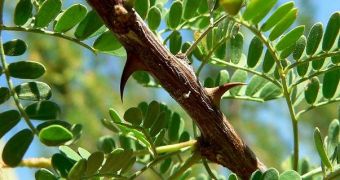British scientists from the Royal Holloway, University of London, have recently revealed in a new scientific paper that the famous acacia plants actually have a symbiotic relationship with their ants. For all intents and purposes, these plants always appear to be overrun with the six-legged insects, which feed on their nectar and take refuge in their thick bark. But the new study reveals that the plants themselves favor this, and also that they control their ant populations via a number of chemicals they release.
The ants that live on acacias are very aggressive, and they also sting, the group says. The researchers add that the chemical the plants release have the ability to send the insects into a defensive frenzy. According to Nigel Raine, the expert in charge of the new investigation, the two species might have learned how to co-evolve a long time ago, to mutual benefits. The ants always have a home that provides them with everything they need, whereas the acacias have their own personal armies, to protect them from other predators, the BBC News reports.
Also involved in the new research were scientists from the universities of St. Andrews, Edinburgh and Reading, all in the United Kingdom, as well as from the Lund University, in Sweden. The group looked closely at the interactions between the two species, in an attempt to determine a few of the mechanisms that made cohabitation profitable. Speaking about the services that the aggressive ants provide to the acacia, Dr. Raine explains that, “They guard the plants they live on. If other animals try to come and feed on the rich, sugary nectar, they will attack them.”
One particular type of acacia-based ant, living in Africa and known as Crematogaster, is also very fearless, the group says. In some cases, it will even start attacking very large mammals that try to feed on the plant's nectar. “If a giraffe starts to eat the leaves of an acacia that is inhabited by ants, the ants will come out and swarm on to its face, biting and stinging. Eventually, the giraffe will get fed up and move off,” the team leader adds. But the plants also had to develop a mechanism of stopping the ants from going into the flowers.
This is essential so as to allow pollination. The plants therefore developed special structures on their stems, which are filled with nectar. This means that the ants don't need to go up to the flowers in order to gather the precious stuff. Additional structures at the tip of the leaves play the same role. However, in some cases, these amounts of nectar are not enough, so a chemical warfare ensues. “The flowers seem to produce chemicals that are repellent to the ants. They release these particularly during the time when they're producing lots of pollen, so the ants are kept off the flowers,” Raine concludes.

 14 DAY TRIAL //
14 DAY TRIAL //